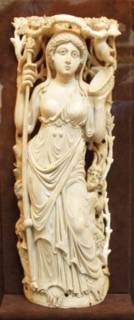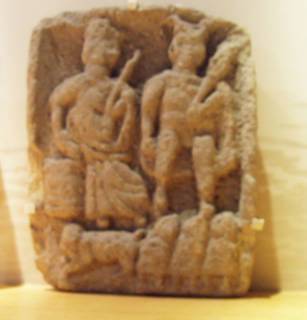
Ariane ivory miniature.



 ROMAN BATHS, BATH, ENGLAND. No one's allowed to go bathing now in these Roman baths, used for many hundreds of years by priests, royalty, and later, the aristocracy. When Rome pulled out, the baths were taken over by the locals and preserved. What amused me most were the many offerings to the gods made here, so that bathing was much more spiritual than today. And curses! "A plague be visited on the foul unmentionable one who took my toga!" These curses were etched on tiny tin or copper scrolls and then tossed into the pools as an offering to the goddess, along with coins. And, in an inner room, a large pool completely enclosed was reserved for the priests and for healing. A niche held a statue of the goddess.
ROMAN BATHS, BATH, ENGLAND. No one's allowed to go bathing now in these Roman baths, used for many hundreds of years by priests, royalty, and later, the aristocracy. When Rome pulled out, the baths were taken over by the locals and preserved. What amused me most were the many offerings to the gods made here, so that bathing was much more spiritual than today. And curses! "A plague be visited on the foul unmentionable one who took my toga!" These curses were etched on tiny tin or copper scrolls and then tossed into the pools as an offering to the goddess, along with coins. And, in an inner room, a large pool completely enclosed was reserved for the priests and for healing. A niche held a statue of the goddess.




 Hatshepsut's statues could be torn down, her prayers effaced, but the tomb remains, monumental, of stone, and enduring. She lived nearly 4,000 years ago, and ruled as the first female Pharoah for nearly 20 years, first as regent for the young Tuthmosis III, and then on her own. The picture shows columns still standing in a small temple dedicated to Hathor on the left side of the tomb. Other reliefs throughout the tomb show Hatshepsut's accomplishments; she negotiated and fought battles with Nubians, and a monumental frieze documents her expedition to the ancient city-state of Punt (today, Somalia), showing marvelous sea creatures, boats, gifts and giant mounds of incense. The frieze is now very difficult to see, colors worn away by sun and wind. An authorized copy was made of this very large frieze; the museum copy is now sharply incised and more brilliantly painted than the original.
Hatshepsut's statues could be torn down, her prayers effaced, but the tomb remains, monumental, of stone, and enduring. She lived nearly 4,000 years ago, and ruled as the first female Pharoah for nearly 20 years, first as regent for the young Tuthmosis III, and then on her own. The picture shows columns still standing in a small temple dedicated to Hathor on the left side of the tomb. Other reliefs throughout the tomb show Hatshepsut's accomplishments; she negotiated and fought battles with Nubians, and a monumental frieze documents her expedition to the ancient city-state of Punt (today, Somalia), showing marvelous sea creatures, boats, gifts and giant mounds of incense. The frieze is now very difficult to see, colors worn away by sun and wind. An authorized copy was made of this very large frieze; the museum copy is now sharply incised and more brilliantly painted than the original.

 . I spotted this variation of the seated "plank" goddess in a small case in the British Museum. These smaller (about hand size) terracotta figurines were made of clay, flat on one side, with more details on the front side, sometimes with only the face shown in any detail. This is a particularly fine "plank goddess" given the details of the modeling. These figurines were often thrown into lakes, found as burial or temple offerings, or (in some variations) found in house rubble as goddesses of the hearth. Note the crown, Greek dress peplum and the details of the swaddling on the baby. It's not certain who she is -- a later version of Ishtar with child? Aphrodite? The location of Boetia puts her in sometime in the Bronze Age, but the details of the figure suggest a later date. I'm interested in the theme of mother and child, venerated well before Christianity. As always, more information is needed!
. I spotted this variation of the seated "plank" goddess in a small case in the British Museum. These smaller (about hand size) terracotta figurines were made of clay, flat on one side, with more details on the front side, sometimes with only the face shown in any detail. This is a particularly fine "plank goddess" given the details of the modeling. These figurines were often thrown into lakes, found as burial or temple offerings, or (in some variations) found in house rubble as goddesses of the hearth. Note the crown, Greek dress peplum and the details of the swaddling on the baby. It's not certain who she is -- a later version of Ishtar with child? Aphrodite? The location of Boetia puts her in sometime in the Bronze Age, but the details of the figure suggest a later date. I'm interested in the theme of mother and child, venerated well before Christianity. As always, more information is needed!



